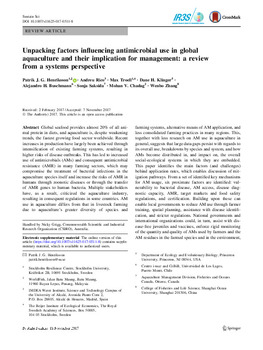Unpacking factors influencing antimicrobial use in global aquaculture and their implication for management: a review from a systems perspective

Citation
Henriksson, P.J.G. et al. (2017). Unpacking factors influencing antimicrobial use in global aquaculture and their implication for management: a review from a systems perspective. Sustainability Science, online first 18 Nov
Global seafood provides almost 20% of all animal protein in diets, and aquaculture is, despite weakening trends, the fastest growing food sector worldwide. Recent increases in production have largely been achieved through intensification of existing farming systems, resulting in higher risks of disease outbreaks. This has led to increased use of antimicrobials (AMs) and consequent antimicrobial resistance (AMR) in many farming sectors, which may compromise the treatment of bacterial infections in the aquaculture species itself and increase the risks of AMR in humans through zoonotic diseases or through the transfer of AMR genes to human bacteria. The main objective of the present report was to identify and describe drivers that could explain the interspecies, intersystem, and/or trans-regional differences in antimicrobial (AM) use in global aquaculture and identify possible mechanisms for reducing AM use in social-ecological systems. Moreover, a methodological approach for the identification of future AM usage scenarios and excessive or unregulated AM 'hotspots' is also proposed, based on governance indices. The overall aim is to help identify areas in which immediate action is required for the establishment of AM use evaluation and to identify environmental and human health regulation schemes, while providing recommendations for diminishing AM use and risks in the future.
Permalink
Date Available
Type
Publisher
ISSN
1862-4065
Research Themes
Topics